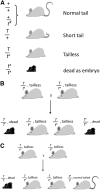Mammalian developmental genetics in the twentieth century
- PMID: 23212897
- PMCID: PMC3512133
- DOI: 10.1534/genetics.112.146191
Mammalian developmental genetics in the twentieth century
Abstract
This Perspectives is a review of the breathtaking history of mammalian genetics in the past century and, in particular, of the ways in which genetic thinking has illuminated aspects of mouse development. To illustrate the power of that thinking, selected hypothesis-driven experiments and technical advances are discussed. Also included in this account are the beginnings of mouse genetics at the Bussey Institute, Columbia University, and The Jackson Laboratory and a retrospective discussion of one of the classic problems in developmental genetics, the T/t complex and its genetic enigmas.
Figures








References
-
- Anderson D. M., Lyman S. D., Baird A., Wignall J. M., Eisenman J., et al. , 1990. Molecular cloning of mast cell growth factor, a hematopoietin that is active in both membrane bound and soluble forms. Cell 63: 235–243 - PubMed
-
- Artzt K., McCormick P., Bennett D., 1982. Gene mapping within the T/t-complex of the mouse. I. t-Lethal genes are nonallelic. Cell 28: 463–470 - PubMed
-
- Atkin N. B., Mattinson G., Beçak W., Ohno S., 1965. The comparative DNA content of 19 species of placental mammals, reptiles and birds. Chromosoma 17: 1–10 - PubMed
-
- Bennett D., 1964. Abnormalities associated a chromosome region in the mouse. II. Embryological effects of lethal alleles in the T-region. Science 144: 263–267 - PubMed
Publication types
MeSH terms
LinkOut - more resources
Full Text Sources
Miscellaneous

